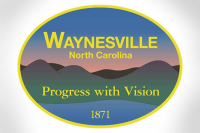Cherokee Preservation Foundation announces fall grants for 2024
The Cherokee Preservation Foundation awarded 10 grants to partners within Western North Carolina. Grants totaled more than $2.1 million and were awarded to projects advancing the Foundation’s mission of improving the quality of life for the Eastern Band of Cherokee Indians (EBCI) and neighboring communities.
Cherokee museum receives $385,000 grant
Museum of the Cherokee People has been awarded a major spring grant from the Cherokee Preservation Foundation.
Shannon Swimmer named director of WCU Cherokee Center
Shannon Swimmer received a master’s degree in human resource management from Western Carolina University in 2007. After several years working in tribal law, Swimmer has returned to WCU in a new capacity, as director of the Cherokee Center.
Living culture: WCU undertakes project showcasing Cherokee heritage on campus
At mid-morning on Wednesday, Nov. 15, the fountain at the heart of Western Carolina University’s campus is a thoroughfare.
Our air, our water: Science program blends indigenous and western methods
In January 2020, Sara Duncan was less than a year into her role as an assistant professor at Western Carolina University’s School of Health Sciences when she started talking to Lisa Lefler, director of WCU’s Culturally Based Native Health Program, about opportunities for kids to get involved in Cherokee science.
History through story: Cherokee storyteller seeks to preserve historical memory with filming project
Kathi Littlejohn can get lost in stories. Especially Cherokee stories. Their origins are often moored in worlds long past, but these stories have a tendency to twist through the years to end up knocking on the door of modernity.
“One of my first jobs as a teenager was working at the Oconaluftee Indian Village, which I absolutely loved. I was a tour guide,” recalled Littlejohn, who is now 63. “And on bad weather days when it was real slow, it was so much fun for me to sit with the people that were doing the crafts or some of the older guides and listen to stories.”
Cherokee Friends — Teaching new visitors old traditions
 By Wil Shelton • SMN intern
By Wil Shelton • SMN intern
Visitors of the Qualla Boundary now have the opportunity to experience Cherokee culture in a new, interactive way.
The Cherokee Friends, a program through the Museum of the Cherokee Indian, funded by the Cherokee Preservation Foundation, aims to offer visitors a taste of Cherokee culture, as well as promote various sights around the community.
Former governor visits Cherokee
Former Gov. Jim Hunt toured Cherokee last week at the invitation of Cherokee Preservation Foundation.
The governor, who helped negotiate the agreements between the EBCI and the State of North Carolina that paved the way for the casino and the establishment of Cherokee Preservation Foundation, came to see how the Foundation has invested in cultural preservation, economic development and environmental preservation over the past decade. He was accompanied by his wife and their daughter Rachel.
During the trip, he toured Cherokee, taking in new facilities and improvements made to the reservation since his last visit nearly a decade ago. He also met with tribal, cultural and community leaders to talk about progress made in recent years. It was his office that allowed the birth of casino gaming on the reservation, so this tour was a chance to see the fruits of that decision, more than 10 years on.
The Cherokee Preservation Foundation has given out more than $50 million to various Cherokee projects since its creation in 2000.
“When I last visited Cherokee ten or so years ago, the cultural organizations like Qualla Arts and Crafts, the Museum, the Drama and Village had wonderful products and programs, but the facilities were dated and not up to par with other venues around the state and region. Ten years later, I see a very different picture,” Hunt told guests at an evening dinner hosted by the Cherokee Preservation Foundation.
Hunt was the governor from 1977 to 1985 and 1993 to 2001. He is the longest-serving governor in the state’s history.
Literary journal honors contemporary literature from the Cherokee community
Readers will be in for a surprise when thumbing through the pages of the all-Cherokee issue of Appalachian Heritage literary journal, which will be celebrated at Western Carolina University next week.
The issue turns on its head every generalization about Cherokee literature that’s been made before. Though it pays due homage to traditional Cherokee myths — in Cherokee syllabary as well as English — the journal also unveils the diversity of literary genres that underlies contemporary Cherokee works.
Annette Saunooke Clapsaddle, a contributing author and English teacher at Swain County High School, said the compilation of Cherokee articles, fiction, poetry and memoirs is all too rare.
“It’s a collection that I really haven’t seen, at least in recent years, in terms of diversity,” said Clapsaddle, who has also been involved in efforts to revive Cherokee children’s literature. “I think that Cherokee literature is more diverse than most people realize. Most people around here are familiar with traditional origin myths, but there’s a vibrant Cherokee writing community here and elsewhere that includes a lot of different genres of literature.”
The story she contributed to the Berea, Ky.,-based journal is a short fictional piece called “It All Comes Out in the Wash.” The story is based on a true tale Clapsaddle heard firsthand from a woman who experienced the horrors of life in a Cherokee boarding school.
“Students had been taught that all clean things are white,” said Clapsaddle. “Her skin was dark, so she thought her skin wasn’t clean. She got her skin bleached.”
Though Clapsaddle sometimes tackles grave topics, she doesn’t believe they comprise the heart of Cherokee literature.
“There’s a lot of humor in our community,” said Clapsaddle. “I like to include that in my writing.”
Clapsaddle became surprised herself when she opened the pages of the literary journal after it was released last fall. Contributing authors not only included distinguished writers like Robert J. Conley and D.L. Birchfield, but also a freshman at Cherokee High School, a chef at Harrah’s Cherokee casino and a former Principal Chief of the Eastern Band, among others.
“It’s fun to discover the talent that the people you live around have that maybe you didn’t know about,” said Clapsaddle. “Some I didn’t even know wrote.”
To get a copy of the magazine, attend Western Carolina University’s event on April 8 (see “Meet the Authors”) or visit community.berea.edu/appalachianheritage.
Cherokee leaders take stock of sustainability goals
Four years ago, Principal Chief Michell Hicks issued a proclamation intended to move the Eastern Band of Cherokee Indians towards environmental sustainability.
Last week, leaders from the tribe gathered to discuss the impact of Generations Qualla, a grant program created by the Cherokee Preservation Foundation to kick-start the effort.
“Going back to the environmental proclamation, it didn’t give us all the pieces or all the solutions,” Hicks said. “But if you look at the parts, the big picture is there.”
The tribe is moving towards long-term goals like developing a wind power system, a truck fleet that runs completely on locally produced biodiesel, and constructing an $8 million eco-business park in Jackson County. But the first steps toward sustainability have been much closer to home.
With the help of grants from the Cherokee Preservation Foundation, the EBCI has created a systemwide recycling program, moved towards energy-efficient building standards and enhanced its mass transit program. While the impacts may feel small now, the foundation’s executive director, Susan Jenkins, said the work of taking on sustainable projects one at a time will bear fruit in the future.
“We as a community –– and that includes the surrounding region –– are looking at what we want the Qualla Boundary to look like for the next seven generations,” said Jenkins.
Jenkins used the tribe’s recycling program as an example. The initiative began with a $70,000 grant to the Cherokee Youth Council to purchase recycling bins and create an education program.
Over the past year, the youth council has traveled to every tribal department to teach employees about what they can and can’t recycle and to stress the importance of recycling.
Jenkins said what began as a simple initiative turned into a learning process.
“We thought it would be simple,” Jenkins said. “The youth council would do the education, and recycling [staff] would do the recycling.”
Along the way, it became clear that a crucial piece of the equation was missing.
“We hadn’t even thought about housekeeping,” Jenkins said.
The youth council was educating tribal employees across departments, but it wasn’t communicating with the janitors who cleaned the buildings and emptied the trash cans.
The recycling staff, meanwhile, was duplicating janitorial efforts by walking all the same buildings and emptying the recycling bins. It may sound crazy, but the tribe hadn’t dealt with a comprehensive recycling system before.
Jenkins said the hang-ups created a network of problem solvers.
“It’s not always just money the groups need. It’s often about the connections, so you can begin to build the capacity,” said Jenkins.
Now the janitorial staff empties all the recycling bins into steel hoppers outside buildings at specified locations, and the recycling staff takes them away when they’re full. The tribe used to only get money for its cardboard and bottles, but these days, it’s also collecting enough plastic to ship to a processing plant.
The success of the recycling program has created a new issue.
“It’s very clear. We’re overloading recycling,” Jenkins said. “How can we bring this to scale and work together to find a solution?”
Jenkins thinks the solution is in uniting the recycling efforts between the hospital, the schools and the casino to create an economy of scale.
“We’ve got the tribe involved. Now can we get the businesses on board, too?” Jenkins said.
None of it would have been possible without the youth council’s effort to educate and push for a solution that made sense.
Jenkins said the intent of Generations Qualla funding is to create a snowball effect that leverages money and connections to create change.
For example, a $50,000 Generations Qualla grant in 2009 funded energy audits on 20 tribal buildings. With the results of the audits in hand, the EBCI Office of Planning and Development pooled another $70,000 grant from Generations Qualla with $130,000 of its own money to match a $200,000 U.S. Department of Energy Grant.
The $400,000 will go towards achieving a 30 percent reduction in energy expenditures at seven tribal buildings.
Preliminary monitoring efforts of the targeted buildings raised concerns about the air quality in the buildings. Now the buildings will also undergo an air quality assessment as part of the energy efficiency upgrade.
Jenkins said the meeting last week was a chance to check in on the progress of Generations Qualla’s initiatives, but it was also a call to action. The Cherokee Preservation Foundation will launch a new round of grant funding in June, and Jenkins hopes to see proposals that will move sustainability agendas past their fledgling stages by creating new partnerships both inside and outside the Qualla Boundary.
Grants are not limited to tribal programs and members. Generations Qualla funding has helped drive the Mountain Landscapes Initiative, a sustainable development toolkit organized by the Southwestern Planning Commission, Haywood Community College’s new low impact development degree, and the U.S. 441 Corridor Plan, among other projects.
For more information go to www.cherokeepreservationfdn.org.





